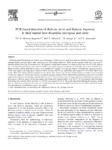Use este identificador para citar ou linkar para este item:
http://www.alice.cnptia.embrapa.br/alice/handle/doc/47048Registro completo de metadados
| Campo DC | Valor | Idioma |
|---|---|---|
| dc.contributor.author | OLIVEIRA-SIQUEIRA, T. C. G. | pt_BR |
| dc.contributor.author | OLIVEIRA, M. C. de S. | pt_BR |
| dc.contributor.author | ARAÚJO JR., J. P. | pt_BR |
| dc.contributor.author | AMARANTE, A. F. T. | pt_BR |
| dc.date.accessioned | 2011-04-10T11:11:11Z | pt_BR |
| dc.date.available | 2011-04-10T11:11:11Z | pt_BR |
| dc.date.created | 2005-05-12 | pt_BR |
| dc.date.issued | 2005 | pt_BR |
| dc.identifier.citation | International Journal of Parasitology, v. 35, p. 105-111, 2005. | pt_BR |
| dc.identifier.uri | http://www.alice.cnptia.embrapa.br/alice/handle/doc/47048 | pt_BR |
| dc.description | PCR and nested-PCR methods were used to assess the frequency of Babesia bovis and Babesia bigemina infection in Boophilus microplus engorged females and eggs and in cattle reared in an area with endemic babesiosis. Blood and the engorged female ticks were from 27 naturally infested calves and 25 crossbred cows. The frequency of both Babesia species was similar in calves and cows (P>0.05). Babesia bovis was detected in 23 (85.2%) calves and in 25 (100%) cows and B. bigemina was detected in 25 (92.6%) calves and in 21 (84%) cows. Mixed infections with the both Babesia species were identified in 42 animals, 21 in each age category. Of female ticks engorged on calves, 34.9% were negative and single species infection with B. bigemina (56.2%) was significantly more frequent (P<O.OI) than with B. bovis (4.7%). Most of the females (60.8%) engorged on cows did not show Babesia spp. infection and the frequency of single B. bovis infection (17.6%) was similar (P>0.05) to the frequency of single B. bigemina infection (15.9%). Mixed Babesia infection was lower (P<O.OI) than single species infection in female ticks engorged either in cows (5.7%) or in calves (4.3%). An egg sample from each female was analysed for the presence of Babesia species. Of the egg samples from female ticks infected with B. bovis, 26 (47.3%) were infected while from those from female ticks infected with B. bigemina 141 (76.6%) were infected (P<0.01). The results showed that although the frequency of both species of Babesia was similar in calves and cows, the infectivity of B. bigemina was higher to ticks fed on calves while to those ticks fed on cows the infectivity of both Babesia species was similar. | pt_BR |
| dc.language.iso | eng | eng |
| dc.rights | openAccess | eng |
| dc.subject | Polymerase | pt_BR |
| dc.subject | Chain reaction | pt_BR |
| dc.title | PCR-based detection of Babesia bovis and Babesia bigemina in their natural host Boophilus microplus and cattle. | pt_BR |
| dc.type | Artigo de periódico | pt_BR |
| dc.date.updated | 2011-07-05T11:11:11Z | pt_BR |
| dc.subject.thesagro | Babesia Bigemina | pt_BR |
| dc.subject.thesagro | Babesia Bovis | pt_BR |
| dc.subject.thesagro | Boophilus Microplus | pt_BR |
| dc.subject.nalthesaurus | Brazil | pt_BR |
| riaa.ainfo.id | 47048 | pt_BR |
| riaa.ainfo.lastupdate | 2011-07-05 | pt_BR |
| dc.identifier.doi | 10.1016/j.ijpara.2004.09.002 | eng |
| dc.contributor.institution | T. C. G. OLIVEIRA-SEQUEIRA, UNESP | pt_BR |
| dc.contributor.institution | MARCIA CRISTINA DE SENA OLIVEIRA, CPPSE | eng |
| dc.contributor.institution | J. P. ARAÚJO JR., UNESP | eng |
| dc.contributor.institution | A. F. T. AMARANTE, UNESP. | eng |
| Aparece nas coleções: | Artigo em periódico indexado (CPPSE)  | |
Arquivos associados a este item:
| Arquivo | Descrição | Tamanho | Formato | |
|---|---|---|---|---|
| PROCIMCSO2005.00002.pdf | 119.39 kB | Adobe PDF |  Visualizar/Abrir |









